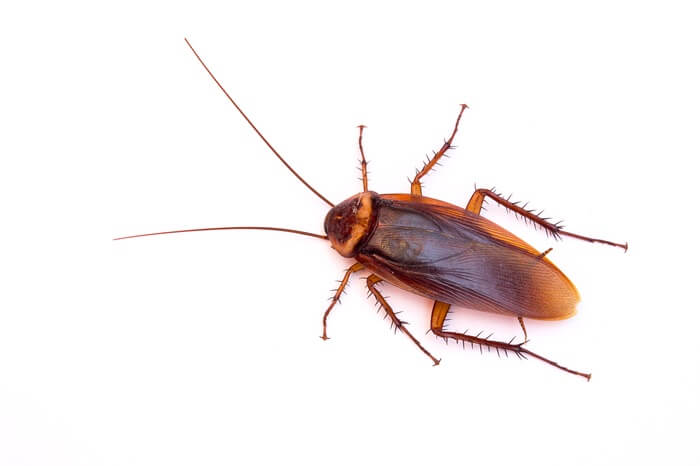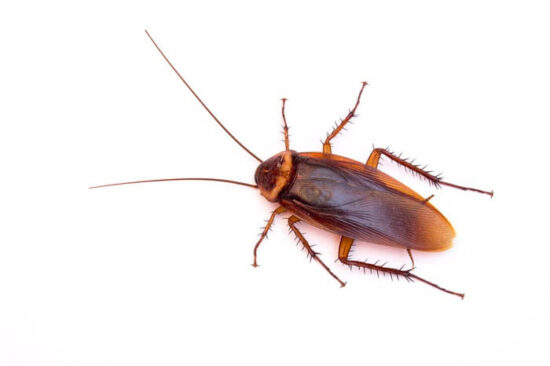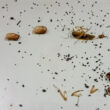If you see one cockroach it’s only natural to wonder if you should be worried or not. Was it just a fluke? Or was it a sign of a serious problem?
This guide will help you figure out how concerned you should be if you only find one cockroach in your home, and verify that it’s not the start of an infestation.
Table of contents
Should I Be Worried?
Seeing one cockroach roaming around the house is a shock to most, since many people associate these pests with filth and disease. While having roaches doesn’t necessarily mean that you live unhygienically, these creepy insects can pose some serious problems in the future (this is especially true if an infestation gets out of hand).
But should you be worried if you see one cockroach?

One lone cockroach isn’t an urgent cause for concern, but it’s definitely not something you should ignore. You might hear some people being woefully optimistic about seeing only one cockroach. But the truth is that there’s a reasonable chance many others are hiding in the shadows!
Here’s why:
Roaches are social insects. They tend to travel in groups and nest in large quantities. Sure, you might encounter one cockroach as it’s scouting for food or looking for a new nesting spot. But that roach is likely part of a much larger colony waiting for its return!
Quick Tip: To make things worse, cockroaches multiply quickly. It doesn’t take long for a small colony to turn into a big one after only a few months of being inside.
There are no guarantees that more cockroaches reside in your home or apartment beyond the single one you saw. But if you approach the situation logically, you’ll quickly realize that the odds are not exactly in your favor.
How Common Is It To Just Have One Cockroach?
While the chances of having only one cockroach in your house are slim, it’s not out of the realm of possibility. You very well could have encountered a solo roach on an exploratory mission through your home.
Here are two situations where this might be possible:
1. Some cockroaches act as scouts for a bigger group. These cockroaches venture out beyond the confines of the nest to look for additional sources of food or shelter.
2. Another possibility is that you came across a roach that was separated from the others. In this case, the lone insect might be looking for means of survival.
These bugs typically enter homes or apartments because of the warmth, easy access to food, and proximity to water. It’s a hospitable environment with everything they need! The cockroach you saw could have been one looking to stay alive.
All of those scenarios can happen. However, it’s never safe to assume! Seeing the one and only roach in your entire home is like finding a needle and a haystack. In all likelihood, you saw one of many.
Because there are no guarantees, it’s important to treat the sighting as if there were more in your home.
Ways To Confirm If There Are More
Once you spot one cockroach in your home, keeping an eye out for more is paramount. Don’t ignore that sighting! Doing so could lead to a major infestation in the future.
Before you shrug off the roach problem, you must look for the presence of others. Here are some surefire ways to confirm if there are more cockroaches in your home.
Check Common Hiding Spots
The first thing you should do is actively look for more of these critters. Sitting idly by and waiting for others to appear is not going to do you any favors. It’s better to be proactive and search all of the go-to hiding spots for cockroaches.
These insects are elusive, choosing to hide in the shadows for most of the day. They’re nocturnal and try to avoid the light as much as possible. As a result, most will find dark areas to nest.
Typically, roaches stick close to food sources, too. So the first place you should look is in the kitchen and bathroom.
Take a peek under appliances, in dark cabinets, and behind larger furniture pieces. Try looking behind spots that hold old food or trash, such as the garbage bin and refrigerator.
Use a flashlight to illuminate the area and see if you can spot them! Once the light hits them, most will scurry back into the dark. However, that movement should make them easy to spot!
Next, shine a light inside drains and pipes. If you have any known areas that like to leak water, check there as well.
Quick Tip: Get creative and search as many places as possible. If you notice any cracks or small openings, don’t be afraid to get in there with a flashlight to see if you can find nests. While cockroaches might be gross, they’re not dangerous. Don’t be afraid!
Look For Droppings
If you can’t find more cockroaches, droppings are the next best thing. Roach poop is small and discrete. But once you know what to look for, you can quickly identify them.
Smaller roaches produce fine pellets. Usually black or brown in color, the waste looks like coarsely ground coffee or flecks of black pepper. Some droppings have more moisture in them, appearing as inkblots or splotchy messes.
Quick Tip: Bigger cockroaches have feces that looks similar to rat droppings. It’s cylindrical in shape and has rounded corners. Look closely, and you’ll notice that each little rice-shaped dropping also has ridges on the sides.
You Discover Signs Of A Growing Colony
Did you know female cockroaches can lay eggs every six weeks? These pests frequently spawn, leading to the quick proliferation of the colony. That means if you only saw one cockroach, the clock could still be ticking.
Roaches don’t just lay single eggs. They produce egg casings, called ootheca, that can hold 10 or 20 individual embryos. Some species (such as the German cockroach) can have casings with as many as 50 eggs!
Finding one of those casings is a telltale sign that you’re dealing with a much larger cockroach problem!
The casings are usually brown and measure about a quarter of an inch long. They’re oval-shaped and are usually broken apart by the time you see them. The ootheca dry out quickly after birth. Some roaches may eat parts of it, so the casing isn’t always visible.
But in the rare event that you do find them, be aware that more cockroaches are likely nearby.
There’s A Slew Of Body Parts
In addition to egg casings, you might find random roach parts lying around.
There are many reasons why body parts get left behind. When cockroaches die, others in the colony sometimes feed on them. Decaying bodies are a valuable source of nutrition that roaches simply can’t ignore.
However, they tend to leave behind:
- Legs
- Parts of wings
- Antennae.
If it’s not a dead cockroach you’re seeing, it’s probably an exoskeleton. Young nymph roaches will molt when becoming an adult. They shed their old skin as they continually outgrow it.
Most cockroaches go through six shedding cycles. When they emerge, the young roaches are usually soft, white, and very susceptible to injuries. As a result, they like to feed on their old skin a bit to regain their strength and lost nutrients.
Quick Tip: Like before, most cockroaches leave some parts behind when they shed. If you see these parts, there’s a good chance the one cockroach you found has backup.
You See Cockroaches In The Daylight
Seeing a cockroach during the day is never a good sign!
It’s one thing to catch roaches hiding in their dark nesting spots. But it’s not a good sign if you saw one cockroach boldly moving around in the open. There’s usually a reason why the insect is out and about.
Remember, cockroaches are nocturnal. They rest in the shadows during the day and search for food at night.
When a cockroach is roaming during the day, it’s usually a means of survival. As colonies get bigger, overcrowding becomes a real issue. Food and water become scarce as more roaches compete to dip into the colony stockpile.
The overcrowding forces many roaches out of hiding in the daylight. They have to find food to survive when they should be resting.
There’s An Unpleasant Smell
Smell is the last telltale sign that the one cockroach you found isn’t alone.
Believe it or not, roaches are smelly creatures! The insects will produce malodorous waste. Pair that with the oleic acid that spills out of decomposing cockroaches, and you have an intense aroma that tends to linger.
You might have noticed a pungent and oily odor throughout your home, but after searching for the source, you can’t find one! There’s a good chance that the source of this smell is a cockroach infestation.
All cockroaches will produce a noticeable smell. But some species are more intense than others. German roaches tend to be the smelliest of them all.
Some say that the aroma is so extreme that it even interferes with taste! So don’t ignore a funky smell. Once it’s noticeable, your cockroach problem is already at a serious stage.
What To Do Next
How you proceed moving forward depends entirely on your findings.
If you discover more than one cockroach, you need to take action immediately. Roach infestations are no joke. Those bugs can cause disease, trigger allergies, and damage your home.
Fortunately, there are plenty of ways to get rid of them. If you want to let a professional take the reins, exterminators have tons of tools at their disposal. They can fumigate your home to get rid of as many cockroaches as possible.
Alternatively, you can take matters into your own hands. Hundreds of chemical-based pesticides are available. You can also try organic pest control methods to eradicate the growing population for good.
But what if you don’t find any more roaches? Even if you were lucky enough to encounter only a single cockroach, you shouldn’t rest on your laurels. The fact that one cockroach made it into your home means that a future infestation is possible.
To avoid that, take preventative measures. Here are some things you can do to decrease your chances of seeing a roach in the future.
Adopt A Strict Cleaning Routine
The most important thing you can do is stick to a cleaning schedule. Take some time out of your week to make your home spotless! Clean all those nooks and crannies where bugs like to hide out.
We also recommend using bug-deterring cleaners on every surface and appliance. Strong bleach-based cleaners eliminate cockroach pheromones and produce a strong enough smell to keep bugs out. The same goes for organic cleaners that utilize essential oils.
Pick Up All Food Remains
Make sure to pick up every last crumb and spill. Leaving tiny remnants of food around your home is the fastest way to draw roaches in. Use a vacuum cleaner to suck up crumbs from carpets and avoid eating in bedrooms or living rooms.
Quick Tip: If you have a young child, keep their hands clean! Kids love to take their sticky hands everywhere and leave behind sweet treats for roaches.
Seal Up Holes
During your search, did you find any holes or cracks that roaches could use to enter your home? If so, use caulk to seal them! Structural cracks in the foundation or walls let bugs from outside come in without much obstruction.
Even interior holes provide an excellent hiding spot for cockroaches. Seal them up and limit where these insects can nest.
Fix Leaks
Leaking pipes are a great way to draw in cockroaches, so you need to address them as soon as possible! The reliable supply of water will attract large roach colonies in no time.
You want to view this as leaving as few survival supplies for these bugs as possible. If you’re able to do this, they’ll have to look for another place to nest.
Examine toilets and fixtures regularly. Also, don’t forget to inspect lesser-known leak sources. Some examples include water lines to the refrigerator, aquariums, humidifiers, and washing machines.
Closing Thoughts
If you see one cockroach in your home it’s a normal reaction to feel a bit worried. No one likes the idea of these little pests crawling around their home!
Using the steps in this guide you should be able to determine if this is a sign of an infestation, or a random occurrence that doesn’t require serious action. While it’s not the most exciting way to spend an afternoon, it’s necessary.


